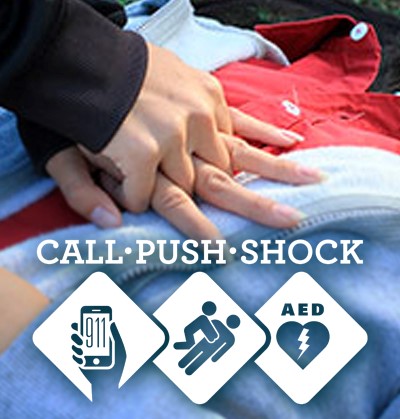With just minutes to save a life using an automated external defibrillator, communities around the country are boosting response times by making the lifesaving devices standard equipment in police cruisers.
Whether it's a suburban Atlanta officer heading home who sped to a nearby office building to shock a man's heart back to life, a pair of Irvine, Calif., officers who reached a man down on a tennis court within three minutes or a New York State trooper helping revive a firefighter who collapsed at an accident scene, adding AEDs to police vehicles is having an impact.
While many public and some private buildings have AEDs, bystanders often don't know they're in place or are reluctant to use them. In many communities, it can take 10 minutes or more for emergency medical units to reach a victim. Police patrol cars roam neighborhoods in greater numbers and potentially offer faster response times.
Yet despite demonstrated advantages of AEDs riding in police vehicles, the practice has been relatively slow to spread, often driven by local volunteers raising money to add the equipment.
Sudden cardiac arrest is different from a heart attack, usually caused by blocked arteries. In cardiac arrest, the heart stops when the electrical pulses that tell it to beat misfire. Only the "reset" from an electrical shock gives it a chance to resume beating.
If an AED delivers a shock within the first three to five minutes after a person's heart stops, studies show, the odds of survival are 60 percent to 70 percent.
In Rochester, Minn., where every patrol car, as well as fire trucks and ambulances, roll with AEDs, the survival rate over the past 15 years has been 58 percent.
Across 1800 square miles patrolled by the Miami-Dade Police Department, response times fell an average of almost 3 minutes between 1999 and 2001, when AEDs were placed in all patrol cars and both police and EMS were dispatched to possible cardiac arrests.
The innovation has been slow to catch on. A survey of state police agencies released in 2011 found only 30 percent equip their vehicles with AEDs, and of those, 60 percent said just a minority of their fleet had them.
''Putting AEDs into more state police cruisers could provide a significant safety net for people who suffer cardiac arrest," said the study's senior author, Dr. Benjamin Abella, assistant professor of emergency medicine at the University of Pennsylvania Perelman School of Medicine.
''I think there are several reasons why more police agencies have been slow to implement these programs. One is concern over legal risk, although the law seems to be moving toward an expectation that AEDs will be available."
Cost - AEDS cost $1,000 and up - and a lack of understanding that the devices are simple and easy to use with minimal training, may also be factors, Abella added.
In New York, a 2005 law requiring AEDs be placed in all public state buildings and facilities also put the devices in all marked State Police patrol vehicles - about 1500 in all, plus about 300 in agency offices.
Tech. Sgt. Jared Pearl, the EMS/AED coordinator for the NYSP, said 6,200 troopers and civilian employees are certified in CPR and AED, with updates every two years. Troopers get emergency medical training before they graduate from the academy, "so they're pretty comfortable utilizing the AED. They see themselves as life-savers from the start."
Since AEDs were first deployed by NYSP in late 2007 through last September, they've been used 1,075 times and have helped save 157 people, the agency said.
''Our people see these as great tools. In rural areas with emergency medical care provided by volunteer crews, we may be able to reach a child or adult in cardiac arrest more quickly and start treatment within that 10 minute window," Pearl said.
Steven Tannenbaum says he came back from death on May 6, 2009, thanks to an AED being in a Nassau County, N.Y., police cruiser. "I am eternally grateful that their vehicles were equipped with AEDs and that the officers were properly trained. I lived because I was delivered three shocks from their AED," he said, adding "it's critical for AEDs to be placed as many locations as possible."
In Rochester, Minn., police put defibrillators in four cars in 1990; today AEDs are in every cruiser patrolling the city. The devices are also aboard all fire trucks as well as ambulances.
Since 1998, when all first responders got defibrillators, Rochester has achieved an overall survival rate of 58 percent for SCA, said Dr. Roger White, a Mayo Clinic emergency medicine researcher who tracks every AED use in the city.
With lean municipal budgets, the only way many police departments obtain AEDs is through donations from civic groups and businesses.
In the newly-formed city of Dunwoody, Ga, north of Atlanta, businessman Bob Lundsten knew how important quick response to cardiac arrest can be. He nearly lost his wife, Kathy, in 2001 at a school gym with no AED.
''I went to the new city council and asked if I could raise money to get AEDs in the police cars. I wanted them to be as much standard equipment as a radio." The community raised some $75,000 by late 2009.
''We've deployed them a number of times. Some were accident victims who did not survive, but we've had four saves," said Chief Billy Grogan.
Dunwoody's cruisers -- and AEDs -- are take-home. Officer Chris Irwin was on his way home from a 12-hour shift last July when he heard a medical call for a man in cardiac arrest at a nearby office building that was just two blocks from a fire station. Even so, Irwin figured he was already rolling and turned his car around.
''He was first on the scene and had shocked the patient three times by the time the EMTs arrived," Grogan recalled. The man survived.
SOURCE: Lee Bowman, Scripps Howard News Service

